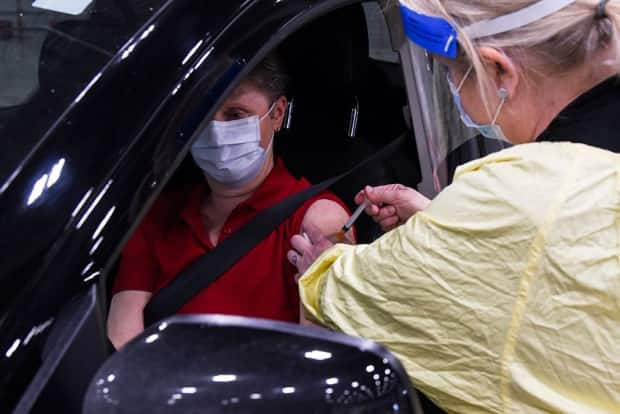Our plan to fight the third wave is a silent admission some Canadians are more valuable than others

This opinion piece is by Dr. Anne Huang, who is a Canadian and U.K.-trained physician.
She was a former deputy medical health officer for the Saskatchewan Health Authority and Indigenous Services Canada's First Nations and Inuit Health Branch in Saskatchewan.
For more information about CBC's Opinion section, please see the FAQ.
As COVID-19's third wave in Canada continues to mount, we're beginning to learn what cannot be readily conveyed by tracing the daily number of new infections: Who are the people behind the numbers shaping the vertical walls of the third wave? And where are the fuelling stations turbo-charging the SARS-CoV-2 coronavirus?
The truth is they are largely immigrants and racialized people working in jobs most susceptible to exposure to COVID-19.
To not act in the best interest of everyone, including those least able to advocate for themselves, is a silent admission that some Canadians are more valuable than others.
My journey as a Canadian began in the English-as-second-language classes of a public high school alongside other teenage immigrants from around the world. I have enjoyed many privileges that have allowed me to be trained as a physician in Canada, but not all immigrants or individuals of visible minorities are as fortunate as I am.
Sharing my knowledge in this piece is a testament to what Canada means to prospective immigrants.
COVID-19 disproportionately affects visible minorities
In October 2020, Statistics Canada reported "immigrants are disproportionately represented in jobs with greater exposure to COVID-19," and that "34 per cent of frontline/essential service workers identify as visible minorities (compared with 21 per cent in other sectors)."
Further, visible minorities are overrepresented in industries worst affected by the pandemic, such as food and accommodation services, which has led to relatively higher unemployment rates.
WATCH | Dr. Anne Huang on why vaccination alone isn't enough:
In its one-year update on COVID-19, Statistics Canada reported that areas with the highest proportion of visible minorities (25 per cent or more) experienced COVID-19 deaths at a rate double that of areas with the lowest proportion of visible minorities (less than one per cent). This contrast was even more pronounced in Quebec, Ontario and B.C.
After many weeks of leading the country in per-capita active case rate, Saskatchewan seemed genuinely surprised by the revelation that "coronavirus classic" and its upgraded versions, the variants of concern, have successfully breached the province's pandemic response.
While social interactions remained subdued by public health orders, invisible crowns of the enveloped RNA virus — clad in its new B117-spiked armour — gained a foothold. They now reign in workplaces and households of public-facing and essential-service workers in the Queen City.
Ethnic origin or race-based COVID-19 data is not publicly available for Saskatchewan. However, based on national analysis conducted by Statistics Canada, it would be reasonable to assume that the pandemic has also disproportionately impacted the health, social and economic status of Saskatchewan's racialized communities.
Or just pay attention next time to who staffs the windows at your favourite fast food drive-thru.
Many essential services cannot be performed at home
Yet the latest round of public health measures announced by the Saskatchewan government on April 13 was devoid of details on how essential service or frontline workers will be protected from the rapidly spreading B117 variant.
This follows weeks of public acknowledgement by officials that measures which were adequate to prevent the spread of COVID-19 in the past are no longer sufficient to stem the current surge of workplace transmissions, and that if infected, the essential-service workers often spread the variant virus to the rest of the family or household members.

Many of these essential services cannot be performed from home, such as meat or produce processing. They provide life-sustaining essentials in our modern world. Workers in these industries put their health and lives on the line so the rest of us can work from home and order groceries, meals and goods online for home deliveries.
There are effective interventions to stop COVID-19 in its tracks:
Upgrade personal protective equipment — better masks — and improve work-site ventilation. This reduces inhalation of virus-contaminated air in shared indoor spaces.
Guarantee access to paid sick/pandemic leave. Current wage subsidy programs don't meet the needs of workers who do not have employer-sponsored benefits and who cannot afford to miss work due to mild symptoms if they will lose income.
Quarantine and isolation accommodation for infected workers. This protects the household and family members from in-home transmissions if there is inadequate space to properly isolate at home. Household or family members of an infected essential-service worker may also work in public-facing jobs themselves.
The lack of such programs one year into a global pandemic in a resource-rich province invites a simple question: Why?
The pandemic is not only testing the intensive-care unit capacity or the economic reserve in Saskatchewan. It is also testing the grand vision of Canada – a democracy built on a mosaic of diversities bounded by egalitarian values.
COVID-19 is testing our notion of what it means to be Canadian — and we must stand on guard for that dream.
Interested in writing for us? We accept pitches for opinion and point-of-view pieces from Saskatchewan residents who want to share their thoughts on the news of the day, issues affecting their community or who have a compelling personal story to share. No need to be a professional writer!
Read more about what we're looking for here, then email sask-opinion-grp@cbc.ca with your idea.

 Yahoo Movies
Yahoo Movies 